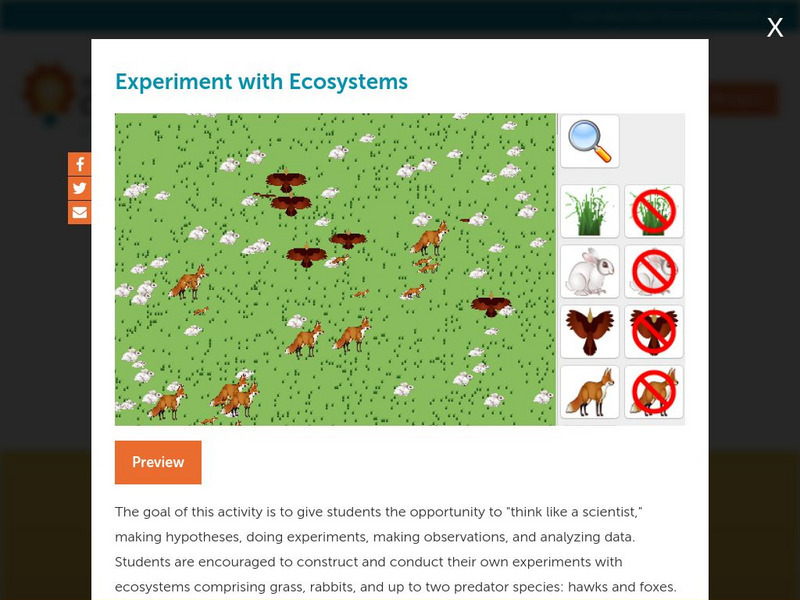Hi, what do you want to do?
Curated OER
Brays Bayou Spiderwort Genetic Study
Students formulate hypothesis based upon data gathered by examining possible crosses of spiderworts using Punnett squares. They present explanations for physiological adaptations of spiderworts that resulted from interactions within the...
Curated OER
Monumental Disappearance
Fourth graders compare the emissions listed on the EPA isopleths over the past five-year period for ten key states. They use this information to rank each region according to the degree of acid rain problem in those parts of the United...
Curated OER
Natural Resources Trick-or-Treat
Students explore that some resources are finite. They are able to deelop an understanding of commodities-some resources are worth more than others so companies choose to spend more money to find them. Students realize that some...
Curated OER
Landfills: A Solid Waste Management Plan
Students are able to list the types of household waste that they produce daily. They are able to describe some other types of waste that are produced by industry or agriculture to help maintain their lifestyles. Students are able to...
Curated OER
Teaching the Complexities of Earth's Systems
An understanding of systems is integral to the study of the Earth.
Curated OER
Insects
Students construct a viable insect collecting apparatus. Students determine the effectiveness of the instrument he has designed by collecting specimens.
Curated OER
Terrariums for Project Pals
Young scholars identify the components needed by plants to survive in the terrarium. In this biology instructional activity, students build their own terrariums using materials available. They present their project in class.
Curated OER
Create a Non-native/Invasion Species
Learners view a video about non-native/invasion species. They create a non-native/invasion species that they think would have an impact on farming, industry, recreation, or water in the local environment.
Curated OER
Name Match
For this name match worksheet, students match up ten species to their description or history by drawing a line between one to the other.
Curated OER
Postcards from the Edge: Endangered Species
Young scholars use the internet to identify the endangered species in their state. Using this information, they create a postcard with a picture of the animal along with facts. They discuss the main reasons to protect the endangered...
Curated OER
Arsenic Globally
Students, using directed questions, identify five internet resources. They use these resources to identify relevant information by highlighting those sections that address the provided questions. Students present the answers to these...
Curated OER
Most Troublesome Exotic Invasive Plant Species Web Quest
Young scholars participate in a Web Quest activity in which they identify common exotic invasive plant species of the Southern Appalachian Region. After identifying the top 10 exotic invasive species, they choose one to research in depth.
Curated OER
Color Your World with Changes --- the Camouflage Game
Seventh graders, after predicting dominant colors foud in their habitat or garden, visit heir area on a monthly basis. They search for colored toothpicks, then graph the results, determining the dominant color for the month.
Curated OER
The Wildland/Urban Interface Dilemma
Students examine all sides of the issues surrounding wildland fire. Groups assume the roles of different people who must decide what to do about a fictitious wildfire. They have a discussion to analyze the issue. A good, real life lesson!
Curated OER
Who Works in This Forest?
Students examine the variety of jobs that are related to working in the forest. Information on the different jobs is provided in this lesson plan for the teacher to share with the students. The students create a collage using magazines...
Curated OER
Cicada Invasion
Young scholars consider how some animals, periodical cicadas, survive well in a particular environment due to the species' life cycle.
Texas Instruments
Texas Instruments: Glencoe Middle School Science: Biodiversity and Ecosystems
Students will conduct a field investigation to learn about the environment. They will observe biotic and abiotic factors of an ecosystem. Students can use the CBL 2 and a temperature probe to collect data and a graphing calculator to...
Population Connection
Population Connection: Population and Environment[pdf]
A paper from the Population Connection that outlines the consequences to the environment if humans continue on the path of overpopulation.
Concord Consortium
Concord Consortium: Stem Resources: Experiment With Ecosystems
Learn what happens to different populations of organisms as their ecosystem changes. Design your own experiment and make your own guesses with what the result will be with this virtual ecosystem. Also experiment with producer/consumer...
Utah Education Network
Uen: Themepark: Systems: Ecosystem
Find a large collection of internet resources organized around ecosystems. Links to places to go, people to see, things to do, teacher resources, and bibliographies.
Open Ed
Open Ed Sci: 7.5 Ecosystem Dynamics
This unit on ecosystem dynamics and biodiversity begins with students reading headlines that claim that the future of orangutans is in peril and that the purchasing of chocolate may be the cause. Students launch a scientific...
Other
My Science Box: Ecosystem Organization
In this lesson, learners will learn about the different levels in the hierarchy of ecology and explain the relationships: organism, population, community, ecosystem, biome, and biosphere. They will also discover why different regions...
TeachEngineering
Teach Engineering: Population Density: How Much Space Do You Have?
Students learn about population density within environments and ecosystems. They determine the density of a population and think about why population density and distribution information is useful to engineers for city planning and...























![Population Connection: Population and Environment[pdf] Article Population Connection: Population and Environment[pdf] Article](https://static.lp.lexp.cloud/images/attachment_defaults/resource/large/FPO-knovation.png)

